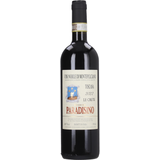Wine And Chocolate
A seductive combination
Both wine and chocolate have been popular and beloved luxury foods for centuries. When wine and chocolate are combined correctly, they create an unforgettable taste experience. In the following article, you'll find out why wine and chocolate go well together and which wines are best combined with which chocolate. You'll also get practical tips on how best to enjoy wine and chocolate together.
Why do wine and chocolate go together?
The combination of wine and chocolate offers an unforgettable taste experience. The prerequisite, however, is that the two stimulants are combined correctly and are of high quality. With the right combination, this "culinary marriage" on the palate results in a mutual reinforcement of the aromas and a slow development of the nuances of taste. Wine and chocolate are judged on the basis of similar characteristics (smell, colour, melt and taste) and last but not least, as popular luxury foods, they ensure a feeling of security and happiness.
Which wines go best with chocolate?
Wine and chocolate offer countless possible combinations. Experiment. but here are some guidelines:
- The colour of the wine should match the colour of the chocolate, ie bittersweet chocolate goes well with strong red wine. White wine, on the other hand, goes well with white chocolate and fruit.
- The wine should always be sweeter than the selected chocolate, otherwise the taste of the wine will take a back seat.
- Choose a wine that has unobtrusive tannins and pleasant acidity. This way the wine and chocolate won't compete with each other and the wine won't leave an unpleasant aftertaste.
Red wines
Cabernet Sauvignon is a popular red wine that usually has a fruity cassis note. The wine has a powerful taste and so goes well with extra dark chocolate. In connection with pieces of fruit, the combination unfolds a special pleasure. Merlot, on the other hand, is a strong red wine that tastes particularly good with dark chocolate. Dry Zweigelt and dark chocolate also result in a harmonious moment of pleasure. The following red wines also go well with dark and bittersweet chocolate:
- Pinot Noir (e.g. from the Austrian Thermenregion or Burgundy)
- Cuvées from Bordeaux
- Beaujolais
White wines
Dry to sweet Riesling, for example, is fantastic with a subtly salted chocolate. The Riesling shouldn't be too young. Instead, choose something 2-3 years old. Pinot Gris and Chardonnay, on the other hand, go well with milk chocolate (cocoa content: 36-45%). Fine milk chocolate and dark chocolate also go well with the following white wines:
- Sauvignon Blanc
- Muskat
- Silvaner
Which chocolates go best with wine?
Depending on your taste, different types of chocolate can be combined with wine. The following chocolates go well with wine:
White chocolate goes well with a sweeter wine. For example, Muskat, Eiswein, champagne demi-sec and rosé port. White chocolate with nuts and spices pairs well with a dry white wine.
Milk chocolate can be combined well with Auslese, Vintage Port, Montilla Moriles and a creamy sherry. Many people prefer milk chocolate because of its creamy sweetness.
Dark chocolate goes well with a strong red wine such as a Primitivo (Click here for the blog post about Primitivo!). Since the bitterness of wine and dark chocolate can reinforce each other, chocolate with a high cocoa content should be paired with dessert wines.
Caramel chocolate sometimes has a slightly salty note and is therefore great with dessert wines such as Vin Santo, Madeira or Amontillado Sherry. These wines have aromas similar to chocolate. In addition, Lambrusco, champagne Demi-Sec or Asti-Spumante emphasise the chocolatey taste.
Nut chocolate. Chocolate that contains roasted nuts is a good choice with an earthy and low-acid red wine.
Enjoy wine and chocolate properly - the tasting
- Take your time for the tasting and create a relaxed and unscented atmosphere.
- Taste the wine and let the smell, colour and taste work on you.
- When you break the chocolate bar, notice the sound and the smell. Taste the chocolate and let it melt in your mouth. Taste the chocolate on all parts of your tongue.
- Take a small sip of wine and let it flow into the melted chocolate in your mouth. With a slight movement of the tongue, the wine and chocolate will combine and be perceived as a unit. When you swallow the wine, you also taste it on the palate and enjoy the intensity and the length of the taste.
- Take three long breaths and take the next sip of wine to intensify the taste experience. If the combination of wine and chocolate tastes harmonious, complements each other and triggers a taste explosion, then the tasting was successful and you did everything right!
Conclusion
When wine and chocolate are properly combined, the two result in a special taste experience. Depending on the type of chocolate and wine, you should follow basic rules for the ultimate taste experience. Of course, you can experiment a lot with different types of wine and chocolate for new taste explosions. Just pay attention to good quality and take your time during the tasting.
Latest reviews
-
 3.5 (2)
3.5 (2)Clos Montblanc Masia les Comes Reserva 2017 Bio, 0,75 L
- Organic cuvée from Cabernet Sauvignon & Merlot
- 18 months barrique, now ideally matured
- Cassis, leather, roasted flavours & a hint of liquorice
€ 21,99 (€ 29,32 / L)Delivery by January 05
-
-
 4.0 (1)
4.0 (1)Pasqua Desire Lush &Zin, Primitivo Puglia IGP 2024, 0,75 L
- Intensely fruity red wine from Apulia
- Dark, powerful, with some residual sweetness
- Great companion for pizzas & burgers
€ 12,99 (€ 17,32 / L)Delivery by January 05
-
-
 4.0 (1)
4.0 (1)Podere Paradisino Le Crete Vino Nobile di Montepulciano 2022 DOCG, 0,75 L
- Traditional ageing over 24 months in wood
- Pure Sangiovese from Prugnolo-Gentile grapes
- Red berries, fine herbal spice and vibrant acidity
€ 20,99 (€ 27,99 / L)Delivery by January 05
-
-
 3.7 (9)
3.7 (9)Superwine OMG it's white, organic , 0,75 L
- 100% organic pecorino from Abruzzo, Italy
- Light, fruity and very accessible
- Elicits an "Oh my God" reaction
€ 9,99 (€ 13,32 / L)Delivery by January 05
-
Magazine Articles:
Discover 9wines Online:
-
Austria: Free standard delivery from € 49,90
-
We operate in a
climate-conscious manner. -
Free
returns Secure payments
with SSL encryption technology






